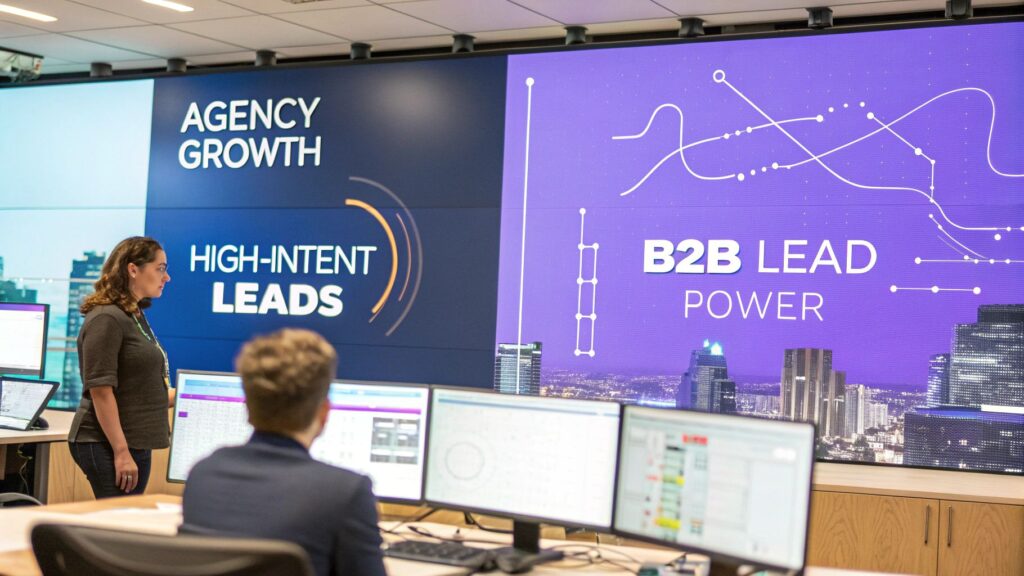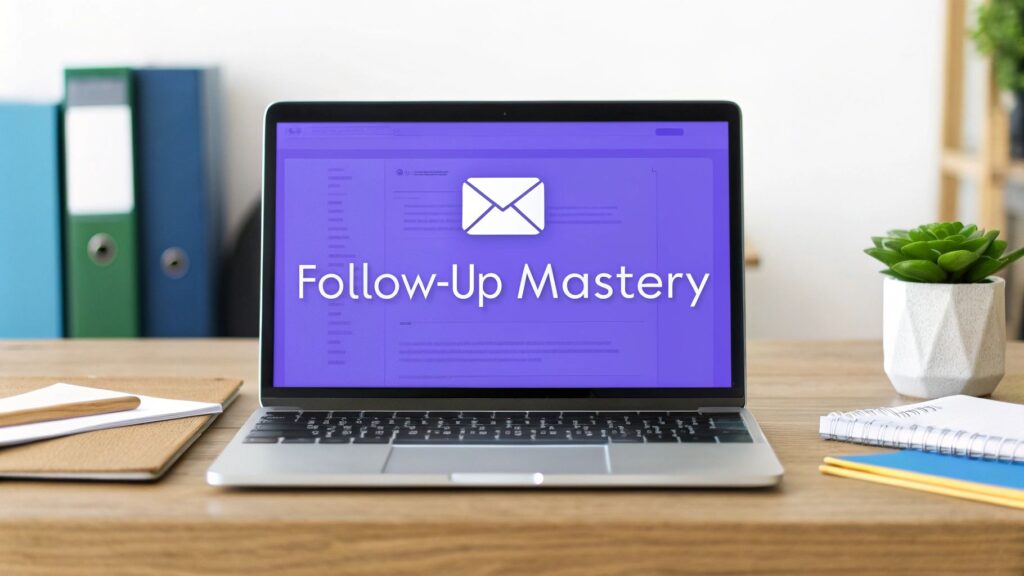What Is Competitive Intelligence and How to Use It
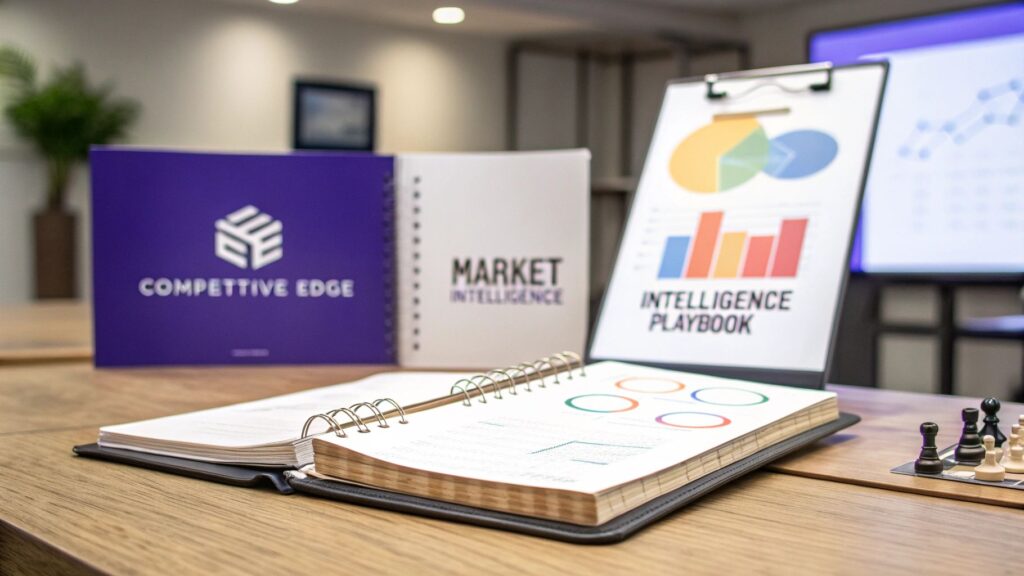
- Understanding Competitive Intelligence Beyond the Buzzwords
- How Competitive Intelligence Drives Real Business Growth
- Building Your Competitive Intelligence Framework
- Choosing the Right Competitive Intelligence Tools
- How AI is Changing the Game in Competitive Intelligence
- Putting Your Competitive Intelligence Strategy into Action
- Got Questions About Competitive Intelligence?
Let's be honest, "competitive intelligence" sounds a bit like something out of a spy movie. But in reality, it's far less about espionage and much more about being a smart, informed business leader.
Think of it as the ethical and strategic practice of gathering, analyzing, and actually using information about your market. This isn't just about your direct competitors; it includes your customers, industry trends, and the broader economic environment. For example, a footwear company might track not just Nike and Adidas, but also shifting consumer sentiment towards sustainable materials and new import tariffs. It’s about turning a sea of public data into your strategic playbook.
Understanding Competitive Intelligence Beyond the Buzzwords

The best analogy for competitive intelligence (CI) is a pro sports team studying game film. The best teams don't just review their own plays. They obsess over their opponents' strategies, analyze player strengths and weaknesses, and look for patterns in past games. Why? To anticipate their next move and prepare a counter-strategy. For instance, a Super Bowl-winning team's coaches spend up to 18 hours a day analyzing opponent footage to find exploitable weaknesses. That's exactly what CI does for your business.
It’s all about connecting the dots. These "dots" are publicly available pieces of information that, on their own, might not seem like much. Think about a competitor's new job postings for "Senior AI Engineer," a subtle shift in their social media tone to be more academic, or a small tweak to their pricing page that adds an "API access" tier.
Individually, these are just minor details. But when you start piecing them together, a much bigger picture emerges. You can spot patterns, predict future actions, and gain a critical edge. In this example, you might accurately predict that your competitor is launching a new AI-powered B2B service in the next six months.
The Growing Importance of CI
This proactive approach is precisely why the global competitive intelligence market is exploding.
The market was valued at around USD 50.87 billion and is on track to hit USD 122.77 billion by 2033. That's a compound annual growth rate (CAGR) of 9.1%, which tells you everything you need to know about how vital this function has become. For a deeper dive, check out the full competitive intelligence market analysis on DataHorizzon Research.
This isn't just a fleeting trend. Research shows that companies with formal CI programs are 37% more likely to experience above-average revenue growth compared to their peers. It represents a fundamental shift in how successful companies operate—moving from being reactive to being predictive.
Key Takeaway: Competitive intelligence isn’t just about collecting data. It’s the art and science of turning raw, public information into actionable insights that guide everything from product development and marketing to your entire long-term business strategy.
Competitive Intelligence At a Glance
To cut through the confusion, it helps to see what CI is—and what it isn't. This quick table breaks it down.
| Component | What It Is (Strategic Focus) | What It Is Not (Common Misconception) |
|---|---|---|
| Data Collection | Gathering publicly available information ethically and legally (e.g., press releases, public filings, job boards). | Corporate spying, hacking, or misrepresenting yourself to gain private information. |
| Analysis | Connecting disparate data points to reveal patterns and predict future actions (e.g., "Their new hires in Germany suggest a Q4 European expansion"). | Simply compiling a list of competitor features or prices without context. |
| Outcome | Actionable insights that inform strategic decisions and give you a competitive advantage (e.g., "We should launch our German marketing campaign in Q3 to preempt them"). | A one-off report that sits on a shelf and gathers digital dust. |
| Focus | Forward-looking and predictive; anticipating market shifts and competitor moves. | Backward-looking; only analyzing what has already happened. |
Ultimately, the goal is to get ahead of the curve, not just react to it.
With a solid CI program, you can start answering the big, game-changing questions:
- What is our main competitor secretly working on for their next launch?
- Where are our rivals dropping the ball and leaving customer needs unmet?
- Is there a new trend on the horizon that could completely upend our industry?
Having the answers to questions like these means you can navigate your market with confidence, grabbing opportunities before anyone else and sidestepping risks before they even become a threat.
How Competitive Intelligence Drives Real Business Growth
Investing in competitive intelligence isn't just a mental exercise; it's what gives your business a real-world edge. Think of it as your company's compass in a chaotic market, pointing you toward the best route to outsmart rivals and seize new opportunities. A solid CI program is the difference between being reactive and proactive—letting you anticipate market shifts instead of just getting hit by them.
This kind of foresight is invaluable. For example, a consumer goods brand like Procter & Gamble could use CI to watch a competitor’s supply chain data and social media chatter. If they see signs of a big holiday discount campaign coming, they can launch their own counter-promotion first, protecting their market share before the competitor even makes a move.
It's the same for a SaaS company. By monitoring competitors' product updates, customer reviews on G2, and feature requests on public forums, you can spot the gaps. Perhaps dozens of users are complaining that a rival's software lacks a crucial integration with Salesforce. That kind of insight goes straight into your product roadmap, making sure your development time is spent on features that actually win new business.
Uncovering Hidden Opportunities
The true magic of competitive intelligence is its ability to shine a light on pathways to growth that were invisible before. By digging into your competitors' weaknesses and identifying customer groups they're ignoring, you can carve out a unique space for yourself in the market.
This infographic breaks down how you can move from anticipating competitor actions to spotting underserved segments and minimizing risks.
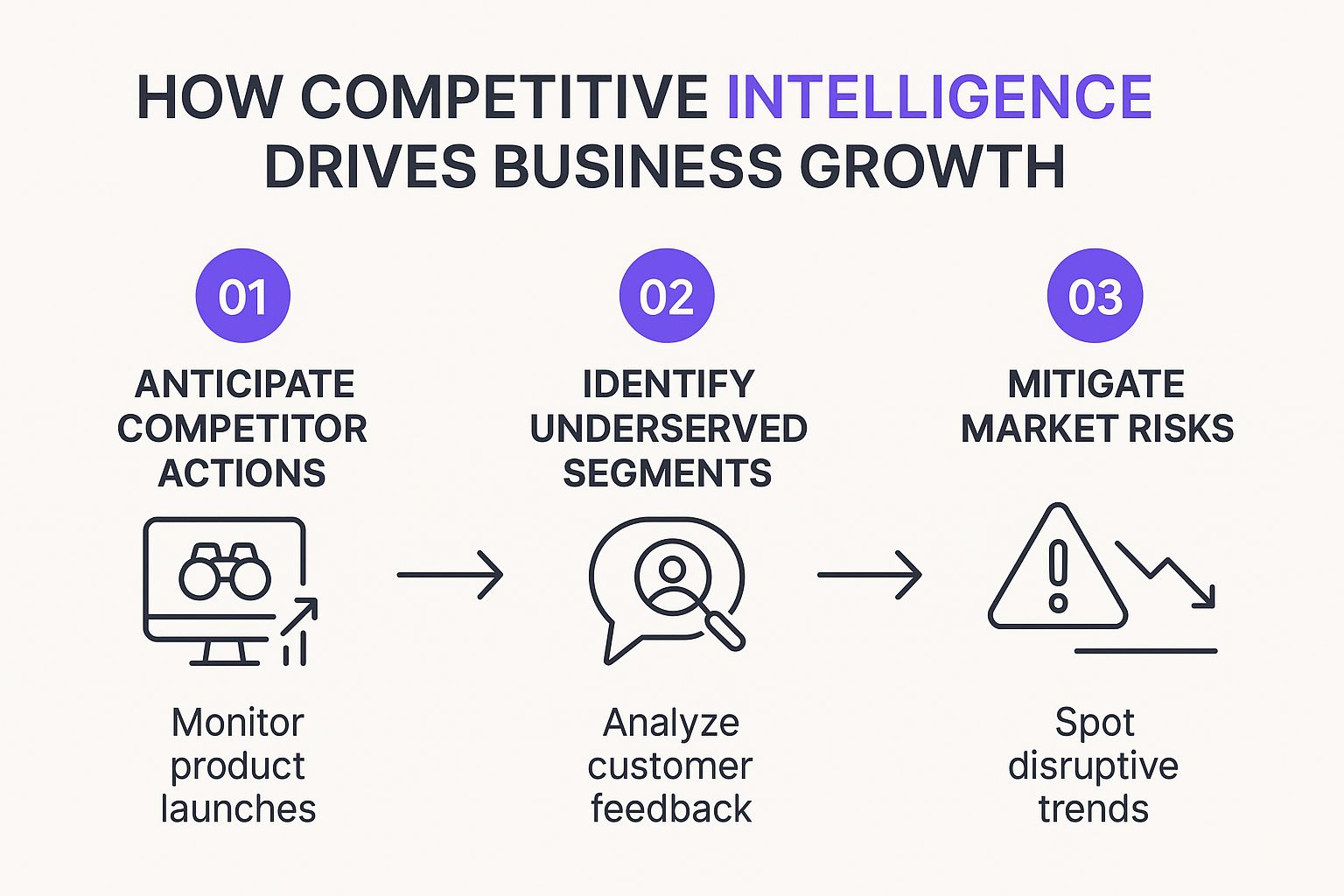
As you can see, it all starts with proactive monitoring. That initial effort is what uncovers specific market gaps, which ultimately helps you build a more secure and strategic position. For example, by analyzing a competitor's customer service reviews, you might find they offer poor support to small businesses, creating an opening for you to target that segment with a superior service promise.
Making Smarter Strategic Bets
At the end of the day, competitive intelligence gives your leadership team the confidence to make bold, informed decisions. When your big moves are backed by solid market data instead of just gut feelings, the entire organization moves forward with more certainty. Studies show that 61% of executives in high-performing companies rely on competitive intelligence to make critical decisions.
Key Insight: A well-run CI program turns market uncertainty into a competitive advantage. It helps you spot risks before they become full-blown threats and grab opportunities before everyone else notices them.
The impact is felt across the whole company:
- Sales teams can sharpen their pitches by zeroing in on a competitor's specific vulnerabilities. For example, "I saw on G2 that users are frustrated with Competitor X's slow load times. Our platform is 50% faster."
- Marketing teams can create messages that truly connect by highlighting the customer pain points your rivals overlook.
- Product teams can build a better product because they have a crystal-clear view of the competitive playing field.
This approach is fundamental to building a company that's both tough and quick on its feet. To learn more about weaving this mindset into your culture, check out our guide on what is data-driven decision-making. By turning raw information into actionable intelligence, you give your team what it needs to win—not just today, but for the long haul.
Building Your Competitive Intelligence Framework

So, how do you actually do competitive intelligence? It isn't just about randomly snooping on your rivals. The most successful programs are built on a disciplined, repeatable process that acts as a kind of engine, constantly turning raw data into strategic action.
Think of it as a four-stage cycle. Each step logically flows into the next, creating a continuous loop that keeps your market understanding sharp and relevant. Let's walk through the blueprint for building a CI function that actually delivers.
Stage 1: Planning and Direction
Before you even think about collecting data, you need to know what questions you're trying to answer. This is hands down the most important part of the process. Here, you'll define your Key Intelligence Topics (KITs)—the big, high-priority questions that tie directly back to your company's strategic goals.
A good KIT is specific and focused, not a vague wish.
- Weak KIT: "What is Competitor X's pricing?"
- Strong KIT: "How will Competitor X's new tiered pricing model, launched in Q3, affect our ability to win mid-market customers in the financial services vertical over the next six months?"
Nailing this stage ensures you don't waste time and money chasing down information that, while maybe interesting, doesn't help anyone make a better decision.
Stage 2: Data Collection
With your KITs locked in, it’s time to start gathering information—ethically and legally, of course. This is all about sourcing raw data from a wide variety of public sources. You want to cast a wide but well-aimed net to get a complete picture of what's happening.
Some of the most common places to look include:
- Company Websites: Keep an eye on changes to their pricing pages, product features, and even the language they use in their marketing copy. A change from "small business" to "enterprise-ready" is a major signal.
- Customer Reviews: Scour sites like G2 or Capterra. This is a goldmine for finding your competitors' biggest weaknesses. Look for recurring complaints.
- Social Media: Track what people are saying about them, monitor sentiment, and see which influencers they're working with.
- Financial Reports: Public filings (like 10-K reports for public companies) can give you incredible clues about a competitor's financial health, R&D spending, and strategic priorities.
- Job Postings: A sudden surge in hiring for AI engineers or European sales reps can signal a major strategic shift long before it's announced.
Stage 3: Analysis and Insights
This is the magic step where raw data is transformed into actual intelligence. It’s all about connecting the dots. You have to look at all these separate pieces of information and find the patterns, trends, and, most importantly, the actionable insights. Just collecting facts isn't the goal; the real value is in figuring out what it all means for your business.
A solid grasp of various competitive analysis techniques is crucial here. A classic for a reason is the SWOT analysis (Strengths, Weaknesses, Opportunities, Threats), which provides a great structure for framing your findings. For example, a competitor's weakness (poor customer support) combined with a market opportunity (growing demand from non-technical users) creates a clear strategic opening for your business.
Key Takeaway: Analysis isn't just reporting what happened. It’s about explaining why it happened and making an educated guess about what’s likely to happen next. That’s what gives your team a real edge.
Stage 4: Dissemination and Action
This final piece of the puzzle is arguably the most neglected. You have to get the right intelligence to the right people, in a way they can actually use. A brilliant analysis that dies in an unread 50-page PDF report is completely worthless.
The goal is to empower your stakeholders—from sales and marketing to product and the C-suite—with insights that help them act. This could be a quick monthly "Competitor Watch" newsletter for your execs, real-time Slack alerts for the sales team when a competitor is mentioned, or a deep-dive report for the product team.
Always tailor the format to the audience. That’s how you make sure your intelligence doesn't just sit there but actually drives smart, strategic decisions.
Choosing the Right Competitive Intelligence Tools
Let's be realistic: manually trying to track every move your competitors make online is a losing battle. From their website updates and social media posts to new ad campaigns and press releases, the sheer volume of information is overwhelming. This is exactly why a modern competitive intelligence toolkit is no longer a luxury—it's a necessity.
Think of these tools as a force multiplier for your team. They automate the grunt work of data collection so you can stop digging and start analyzing. Instead of spending hours hunting for information, you can focus on what it all means and how to act on it. A good CI platform can ping you the second a competitor changes their pricing, gets a flurry of bad reviews on Trustpilot, or is mentioned in the news.
Categorizing Your CI Technology Stack
The market for CI tools is exploding. It's projected to jump from USD 0.59 billion to USD 1.46 billion by 2030, a clear sign of how critical this function has become. Cloud-based tools are at the forefront, accounting for about 78% of the market as companies demand more flexible and powerful solutions. For a deeper dive, you can explore the full CI tools market analysis on Mordor Intelligence.
To build an effective CI tech stack, you first need to know what's out there. Most tools fit into a few main categories:
- All-in-One CI Platforms: These are your command centers. Tools like Crayon and Klue pull everything together—website changes, social media chatter, product reviews, and more—into one clean, searchable dashboard.
- Social Media Listening Tools: Platforms such as Brandwatch are designed to tap into the public conversation. They're perfect for monitoring brand sentiment, catching viral trends, and seeing what real customers are saying about your competition.
- Market Intelligence Software: These tools give you the 30,000-foot view. Platforms like Similarweb or SEMrush focus on broader industry trends, website traffic, market share, and company financials, helping you understand the larger context your competitors are operating in.
The screenshot below from Crayon gives you a great visual of how a dedicated platform can centralize all these different streams of information.
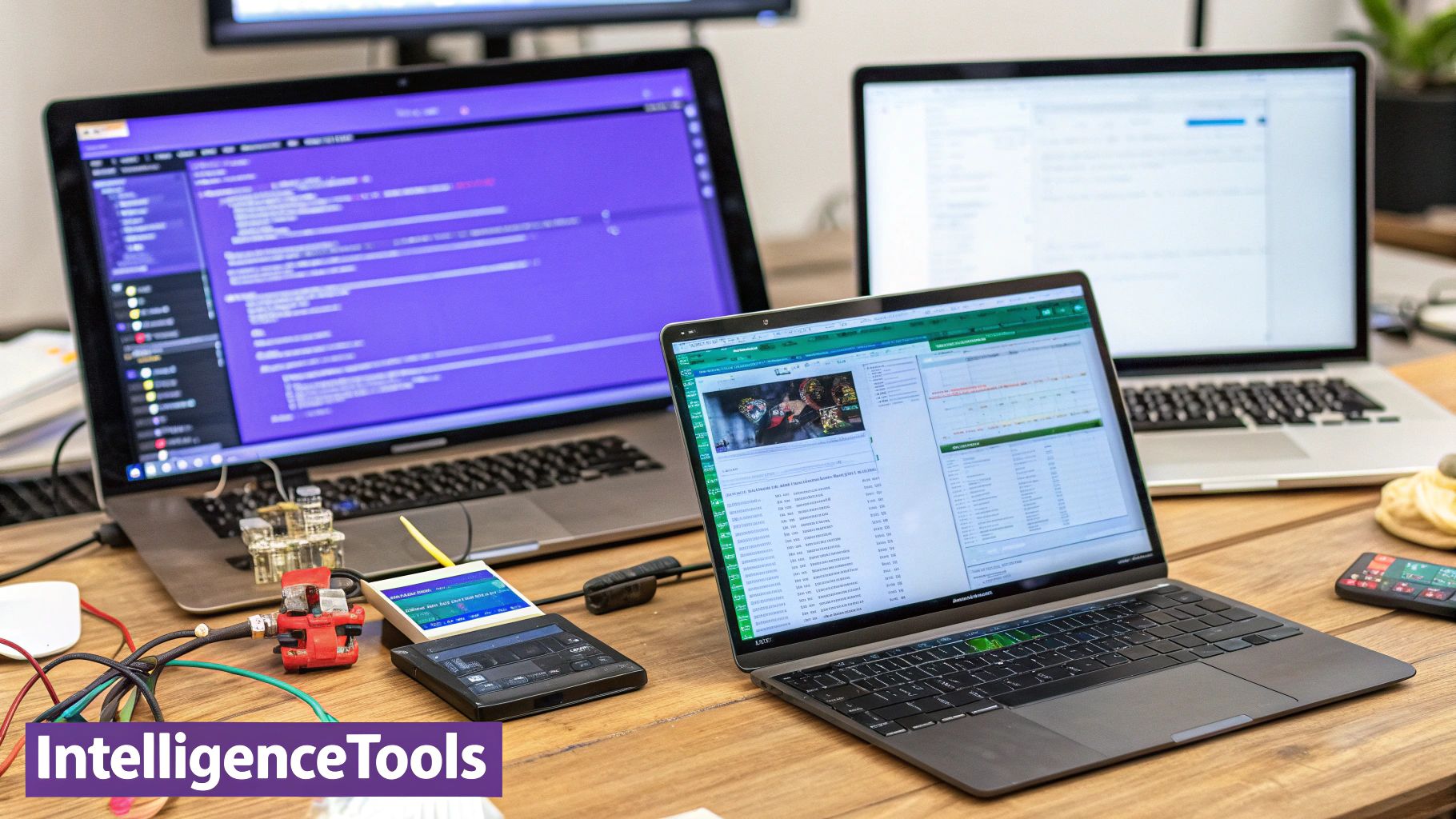
Notice how the dashboard is built around real-time alerts and organized feeds. This design helps teams quickly spot important competitor movements without getting bogged down in useless noise.
Making Technology Actionable
The whole point of using CI tools is to make intelligence easy to find and act on for everyone in the company, not just the research team. For example, a platform like Klue can automatically update sales battlecards with the latest talking points on how to win against a specific rival, delivering the insight right when your sales reps need it most. Imagine a salesperson getting a Slack notification with a new customer testimonial trashing a competitor, just minutes before a call with a prospect considering that rival.
Key Insight: The best competitive intelligence tools do more than just collect data. They weave insights directly into your team's daily workflows, turning information into a real competitive advantage at the point of action.
This integration is everything. Picking the right software isn't just about gathering data—it's about creating a living, breathing strategic function for your entire company. By connecting the dots, you build a much richer picture of your market. To take it even further, consider how you can supplement your competitive data by checking out our guide on the best data enrichment tools.
Navigating the landscape of CI software can be tricky, so it helps to break down the options by what they do best.
Types of Competitive Intelligence Tools
Here's a look at the main categories of tools and how they can support your CI program.
| Tool Category | Primary Function | Example Use Case |
|---|---|---|
| All-in-One CI Platforms | Aggregate and analyze data from multiple sources (web, social, news, reviews) into a central dashboard. | Automatically tracking a competitor's pricing page changes and alerting the product marketing team via Slack. |
| Social Media Listening | Monitor brand mentions, sentiment, and conversations across social networks. | Identifying a surge in negative customer feedback about a competitor's new feature release on Twitter and Reddit. |
| Market Intelligence | Provide high-level data on market size, industry trends, and company financials. | Assessing a competitor's declining website traffic and market share before entering a new region. |
| SEO & Content Tools | Analyze competitor keyword strategies, backlink profiles, and content performance. | Discovering a competitor is ranking for high-intent keywords like "best alternative to [your product]" that your company is ignoring. |
| Ad Intelligence | Track competitors' digital advertising campaigns, creative, and spending across channels. | Seeing which ad copy ("Save 30% Today!") and visuals a rival is using for their most successful campaigns on Facebook. |
| Review Monitoring | Aggregate and analyze customer reviews from sites like G2, Capterra, and the App Store. | Spotting a common complaint in a competitor's reviews that highlights a weakness your product can solve (e.g., "The mobile app is buggy"). |
By understanding these different types, you can start to piece together a technology stack that gives you a complete, 360-degree view of the competitive landscape.
How AI is Changing the Game in Competitive Intelligence
https://www.youtube.com/embed/U46MqPLHv6g
Think of it this way: if old-school competitive intelligence was like painstakingly searching through a library card catalog, using AI is like having a personal research assistant who has already read every book and can instantly give you the exact summary you need.
Artificial intelligence is fundamentally changing the entire field. It’s shifting CI from a practice of looking in the rearview mirror to one that looks out the front windshield, helping businesses see what’s coming down the road and anticipate competitor moves before they even happen.
This isn’t some futuristic idea; it's what's happening right now. AI algorithms can chew through millions of data points in the blink of an eye—everything from news articles and patent filings to customer reviews and job postings. They’re designed to pick up on the faint signals of change that a human analyst, no matter how skilled, could easily miss. That means you can spot emerging threats and opportunities faster than ever before.
From Data Overload to Genuine Foresight
The real magic of AI here is that it frees up your human experts to do what they do best: think strategically. Instead of getting bogged down in the mind-numbing work of collecting data, analysts can focus on connecting the dots and offering real strategic advice.
Here are a few areas where AI is already making a huge impact:
- Sentiment Analysis: Need to know how a competitor's new product is really doing? AI can analyze thousands of social media posts and reviews in minutes to give you a clear picture of public opinion, often scored from -1 (very negative) to +1 (very positive).
- Market Trend Prediction: AI can identify subtle shifts in consumer behavior or new technologies by analyzing millions of articles and search queries to help you see where the industry is heading next.
- Automated Monitoring: You can set up alerts for just about any competitor activity you can think of, from a new ad campaign to a change in their leadership team mentioned in a local news outlet.
By taking over the heavy lifting of data processing, AI transforms competitive intelligence from a reporting tool into a forward-looking strategic weapon. It lets you act on what’s likely to happen, not just what has already happened.
And this kind of power is becoming more and more accessible. Generative AI, in particular, is shaking up what's possible in CI and what it costs.
In fact, the cost to run powerful AI models dropped by over 280-fold between late 2022 and late 2024, thanks to better hardware and energy efficiency. You can dive deeper into these findings in the AI Index Report from Stanford HAI.
These advancements don't just affect CI directly; they also boost other business functions that feed into it. For example, AI is now a core part of many lead generation automation tools, helping sales teams pinpoint high-intent prospects by reading the same market signals.
Putting Your Competitive Intelligence Strategy into Action
Knowing what competitive intelligence is and actually building a program are two very different things. Making that jump can feel massive, but the trick is to start with a focused, practical approach that gives you some quick wins. Forget trying to boil the ocean.
Your first move? Get leadership on your side. This isn't just about asking for a budget. It's about showing them exactly how your CI efforts will move the needles they care about most—things like revenue growth, customer retention, or grabbing more market share. Come prepared with a specific example: "If we can increase our win rate against Competitor X by 10%, that translates to an extra $250,000 in ARR this year."
Building Your Foundation
Once you have that buy-in, don't fall into the trap of trying to track every single competitor. That’s a recipe for burnout.
Start small. Pick just two or three key rivals. These should be the ones who are either your biggest threat (Tier 1) or your biggest opportunity right now (Tier 2). Keeping your scope tight makes the whole process manageable and lets you get your system down before you try to expand.
Set some clear, achievable goals for your first run:
- Find Competitor Weaknesses: Dig for gaps in their product or service that your sales team can immediately use in their calls. Proving you can bump win rates by even 5% against one competitor is a huge win.
- Get Ahead of a Product Launch: Keep an eye on things like their job postings, patent filings, or press releases. These are often clues about their next big move.
- Figure Out Their Pricing Game: Actively track any changes they make to their pricing page. This intel is gold for refining your own product packaging and market position.
Fostering a Culture of Intelligence
A top-tier CI program can't live in a silo. It has to be a resource for the entire company, with information flowing freely between departments. Get your sales, marketing, and product teams in the habit of sharing what they're hearing on the ground from customers and prospects. A great practical step is creating a dedicated Slack channel (e.g., #intel-feed) where anyone can drop a competitor tidbit they find.
A common mistake is treating CI as a one-way street where an analyst just delivers reports. True success comes from creating a feedback loop where frontline teams contribute intelligence and, in return, receive actionable insights that help them win.
When you build this kind of collaborative system, you turn a bunch of random data points into a powerful, shared map of the competitive landscape.
Common Pitfalls to Sidestep
As you get started, watch out for a few common traps. The biggest one by far is confusing data collection with actual analysis. A huge spreadsheet of facts about a competitor isn't intelligence. The magic happens when you connect the dots and explain what it all means for your business strategy—the "so what?" factor.
Also, it’s critical to maintain strict ethical boundaries in how you gather information. For a deeper dive on integrating new technologies responsibly, check out a practical guide to implementing AI in your business.
If you start smart and steer clear of these hurdles, you’ll build a CI function that delivers real, measurable value right from the start.
Got Questions About Competitive Intelligence?
As you start putting these ideas into practice, you’ll probably have a few questions pop up. Let's tackle some of the most common ones to clear the air and help you get started on the right foot.
Is Competitive Intelligence Ethical?
Yes, it absolutely is—when it’s done right. Think of it this way: ethical competitive intelligence is like being a great detective, not a spy. You’re piecing together clues that are already out in the open.
We’re talking about information from news reports, company websites, public financial documents, press releases, and even social media. It's all about gathering publicly available data. The ethical line gets crossed when someone resorts to illegal activities like hacking, corporate espionage, or lying to get private information. The goal is strategic insight, not sabotage.
How Is CI Different From Market Research?
This is a great question because the two are often confused. While they're related, they serve different purposes.
Market research takes a wide-angle view of the entire industry. It's focused on understanding the bigger picture: customer behavior, market size, and general trends. A market research report might say, "The market for project management software is growing at 12% annually."
Competitive intelligence, on the other hand, is like zooming in with a telephoto lens. It sharpens the focus on specific competitors and other forces to answer a much more pointed question: "What are we going to do about it?" CI takes that market growth data and adds, "Competitor A is capturing most of that growth because their new AI feature is resonating with enterprise clients. Here's how we can counter it."
How Can I Measure the ROI of a CI Program?
Measuring the return on investment for CI isn't always as simple as plugging numbers into a spreadsheet, but it's definitely possible. The trick is to connect your intelligence efforts to tangible business results.
You can track things like a higher win rate against your main rival, a noticeable bump in market share, or even the money you saved by sidestepping a strategic mistake that your competitor made.
Imagine your team gets a tip that a competitor's new product has a major flaw. If your sales reps use that insight to close 15% more deals over the next quarter, that's a direct, measurable return. Tracking these specific wins is the best way to prove the real-world value CI delivers.
Ready to stop guessing and start targeting the right companies at the right time? FundedIQ delivers curated lists of recently funded startups, complete with decision-maker contacts and critical buying signals. Get your first high-intent lead list today.



